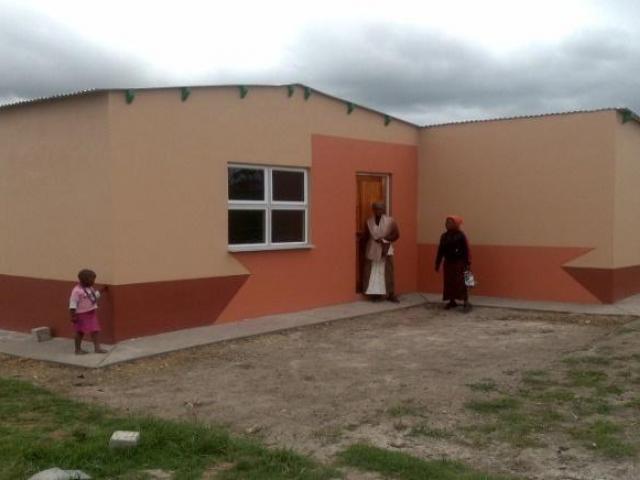The Elliotdale Rural Sustainable Human Settlements Pilot Project (ERSHSPP) is part of the Enhanced Peoples’ Housing Process (EPHP) identified in 2004 for piloting the rural pilot projects in Limpopo and the Eastern Cape. The Eastern Cape Provincial Department of Human Settlements (ECDoHS) approved 7 000 housing subsidies for wards 17 and 26 with Mbhashe Local Municipality to implement a rural pilot on breaking new ground (BNG) principles.
The DBSA entered in a partnership with the ECDoHS in 2010 to initially pilot the construction of housing units in the upper Mncwasa and Ntsingizi in ward 17 and Ngqatyana in ward 26 in Elliotdale. Prior to appointment of the DBSA as an implementing agent, the ECDoHS had called for an expression of interest for the construction of houses in Elliotdale but failed to secure responses from contractors because of the difficult terrain, remoteness of Elliotdale and the thin margins that are typically associated to rural housing delivery initiatives.
Objective of the programme
The objective of the ERSHSPP was to model innovative strategic approaches that address the overwhelming lack of adequate shelter in the Elliotdale area of the Eastern Cape. The projects retained the rural character of the community without imposing an invasive and alien architectural and spatial planning theme of a township development that has been associated with typical RDP housing projects.

Housing units constructed
The Elliotdale project allowed the subsidy budget from the department’s Enhanced Public Housing Process to be utilised for housing products required by a rural homestead. Thus a bouquet of housing typologies bearing a range of products were developed together with an accompanying cost breakdown of each typology that fits within the quantum budget for a housing subsidy.
The housing typologies include housing plans of various sizes and shapes, a water harvesting tank, a cooking stove, a solar panel, even a fridge, and homestead fencing works. Depending on the house type, building materials and size selected, the beneficiary may be able to fit in the quantum budget most of the additional housing products as preferred, depending on their most pressing need.
The qualifying Elliotdale community members were presented with a catalogue, from which they chose their preferred housing typology before construction commenced.
The DBSA has since 2012 constructed and completed 4 300 houses in Elliotdale with over 12 900 households benefitting. The development impact of the project is encapsulated in the Elliotdale Sustainable Development Plan that looks at the planned investment through the lens of sustainable rural human settlement and not simply as a project to build houses.
Lessons learned
-
Beneficiary identification
Delays in loading beneficiary subsidy data on the Housing Subsidy Scheme (HSS) affected the readiness to construct. The beneficiary administration, selection of house typologies was therefore done upfront to enable bulk procurement of materials on site.
- Social facilitation is a critical success factor
Though communities remained active in the project, the social facilitation programme during Phase 1 was not structured to effectively resolve issues related to convincing beneficiaries and traditional leadership to provide alternative sites or relocate the beneficiary where it would be extremely difficult to build a house due to bad terrain. An adequate budget for social facilitation needed to be made to ensure regular engagement with all stakeholders, especially the community and beneficiaries.
- Integration of access roads construction/re-gravelling
Due to bad terrain and sparsely populated sites and extremely uneven terrain, the construction programme is at risk as the contractors have to cut extensive kilometres of road which was not budgeted for in the allocation/subsidy.
- Spatial planning not adequately factored
The spatial referencing of the sites had not been a focus though an intent. Adequate budget is required to enhance the planning scope to include proper surveying of the sites and development of GIS coordinates for the housing units under construction. This should translate into updates of the surveyor general information
- Allocation of appropriate number of housing units irrespective of capacity or higher grade
The terrain in the area challenged all contractors, both big and small. The strategy should therefore be focusing on allocating not more than 500 housing units to higher grade contractors (from CIDB Grade 8 and higher) while introducing a performance-based allocation model, where additional units will be allocated upon completion of the initial units within a specific timeframe.
- Direct intervention on critical construction material components
Most of the delays attributed to contractors’ claims for extension of time with or without cost are associated to the inability to acquire critical material, especially ready mix concrete and building blocks. The material is not necessarily unavailable but the biggest challenge is the unwillingness of suppliers to deliver due to bad terrain. Almost all the contractors are currently double handling or triple handling the material. The approach going forward will include issuing of guarantees to concrete suppliers and block brick manufacturers on supply with an option of direct supplier payment where the contractor fails to do so.
- Management of contractors
South African contractors are highly familiar with the Joint Building Contract Committee (JBCC) Principal Building Agreement but not knowledgeable in terms of the obligations espoused in the contract. The area around claims relating to extension of time and realities of penalties in case of non-delivery has not been accepted by contractors as part of business. Contractors meetings should be used as learning and education forums, where principal agents workshop contractors on the current contract administration pitfalls and what can be expected. This will ensure that the penalty regime and claims procedure is understood by contractors and will avoid disputed claims that often result in adjudication or arbitration.




